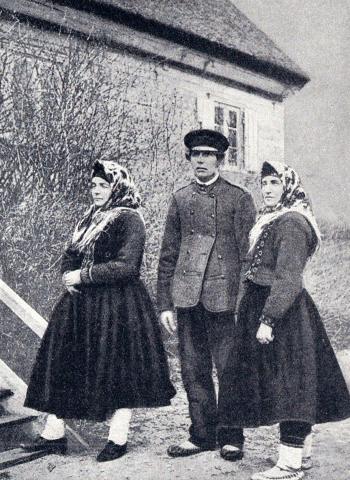
HANDSOME TRIO OF THE RUSTIC POPULATION
The variety of costume worn by this Lettish farmer's wife and daughter is sobriety personified; nevertheless, a touch of colour and originality is displayed respectively in the bright-hued head-kerchiefs and the thickening of the legs by several pairs of stockings
The transit trade between Latvia and Russia was reduced to a negligible quantity, but when the latter country shall have regained a footing in European markets, Latvia anticipates a development in her economic position by acting as commercial intermediary between Eastern and Western Europe, her very advantageous geographical position making her the natural and most convenient place of call for countries trading with Russia. Latvia thus performs an economic function of great international importance. In safeguarding her sovereignty and other vital interests, the interests of many other States are likewise ensured.
Brought by a stroke of evil fortune in 1887 under the control of the Russian Ministry of Education, the Lettish schools suffered a blow that well-nigh extinguished the vitality of all Lettish cultured life. The main purpose of the new "Educators" in Latvia was the Russification of the people. All secondary and higher schools conducted in non-Russian languages were closed, and even in the primary schools it was only in the first grades that Lettish was allowed to be taught; whilst all higher grades had to be taught in Russian.
Now, however, the country is well provided with its own primary and secondary schools—attendance being compulsory until the age of sixteen. Higher education is no less ably conducted than elementary. The University of Tartu (Dorpat) formerly served the three Baltic provinces, but when these acquired their independence, Tartu was naturally recognized as an Esthonian institution, and the Latvian Government lost no time in drawing up plans for a national university of its own. The old Polytechnic Institute of Riga was chosen, its buildings were extended, and in Sept., 1919, the University was formally opened, the initial enrolment totalling 1,258 students, which has increased to over 5,000, including both sexes.
 Gallery
Gallery